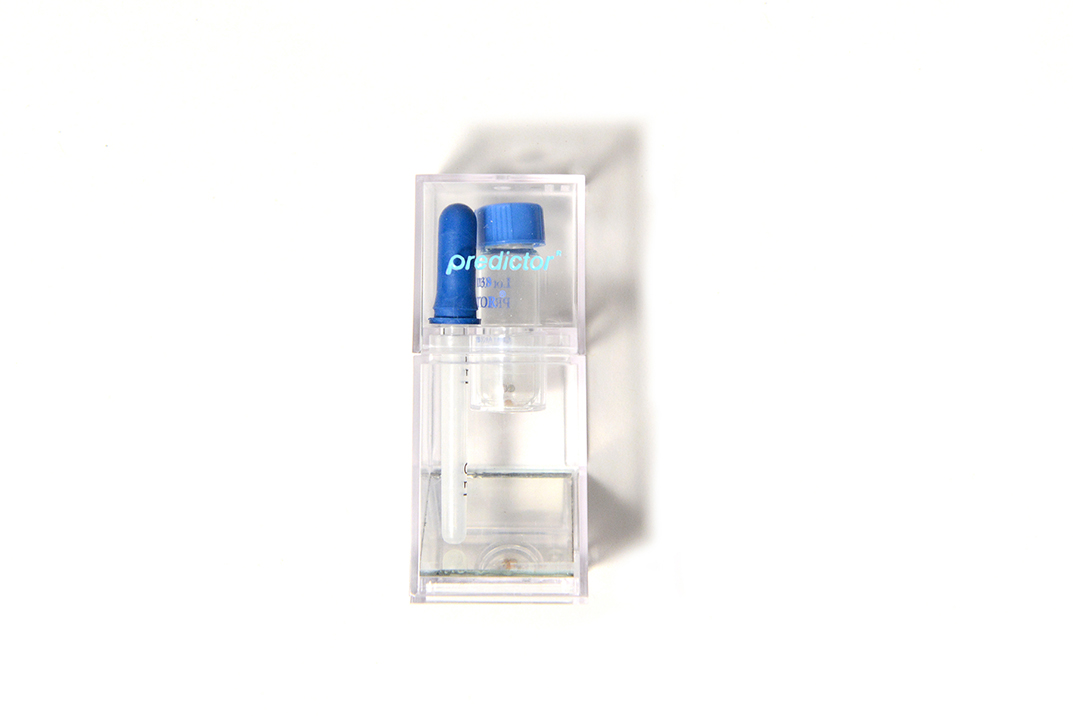First At Home Pregnancy Test & The History Behind It
The Smithsonian Magazine recently published an article focusing on the history of the first at-home pregnancy test. After reading said article, I realized that in the past 9 years, I have taken hundreds of tests, but yet I never once questioned the origin of them. And I question everything. (Understatement of the year.)
Yes, I have taken hundreds of pregnancy tests. When we tried to conceive our first baby, it was 11 unsuccessful months of wasted money on those expensive brands, and I probably pee'd on at least 6 or more each cycle just to see if I could make a second line appear. By the time we were trying for baby #2, I had learned about the dollar tests (Hello Dollar Tree!), and the even cheaper tests found online. You can buy a bulk pack of 100 for next to nothing! Let's just say that I pee'd through more than one order of those from baby #2-baby #5. It's actually quite addicting to pee on sticks (or dip them, whatever). It's even more addicting to see the faintest (almost non-existent) line appear and become darker on those pee-sticks. Seriously, you can pee every few hours and start a comparison line.
 Have you ever wondered who created the home pregnancy test? If you assumed it was a woman, you would be correct! Margaret Crane, a 26-year-old freelance graphic designer was working at the now-defunct pharmaceutical company 'Organon,' in West Orange, New Jersey in 1967. While Crane designed packaging for lipsticks and ointments, she saw how simple it was for those in charge of the pregnancy lab work to complete the process of confirming or denying pregnancies. It didn't take long for her to realize that women could do it themselves -- at home!
During the 60's (and prior), women had to wait about two weeks after seeing their doctor to confirm a pregnancy. Their tests had to be sent into a lab. But, according to Crane, this was a process that could have been skipped altogether! Just like many things though, her idea was shot down and fought against by the company. It would steal their business; not to mention, a woman had come up with the idea... Crane persisted.
Even though she was not a scientist, Crane managed to create a prototype. Her design skills came in handy for the packaging too. She used a clear box that she modeled after a paper clip container. All together it looked like a fun chemistry set!
Crane called the at-home test "Predictor."_x009d_
Have you ever wondered who created the home pregnancy test? If you assumed it was a woman, you would be correct! Margaret Crane, a 26-year-old freelance graphic designer was working at the now-defunct pharmaceutical company 'Organon,' in West Orange, New Jersey in 1967. While Crane designed packaging for lipsticks and ointments, she saw how simple it was for those in charge of the pregnancy lab work to complete the process of confirming or denying pregnancies. It didn't take long for her to realize that women could do it themselves -- at home!
During the 60's (and prior), women had to wait about two weeks after seeing their doctor to confirm a pregnancy. Their tests had to be sent into a lab. But, according to Crane, this was a process that could have been skipped altogether! Just like many things though, her idea was shot down and fought against by the company. It would steal their business; not to mention, a woman had come up with the idea... Crane persisted.
Even though she was not a scientist, Crane managed to create a prototype. Her design skills came in handy for the packaging too. She used a clear box that she modeled after a paper clip container. All together it looked like a fun chemistry set!
Crane called the at-home test "Predictor."_x009d_
 While her version of the pregnancy test was not as modern as the sticks we pee on today, they delivered accurate results within 2 hours instead of the 2 weeks women were used to waiting.
Crane partnered with Ira Sturtevant, an ad man, to help her product reach women everywhere. But because of the FDA's approval procedures, it was not until 1976 that the Predictor became available within the United States. Crane continued to fight to get the pregnancy test on shelves everywhere, and thanks to Sturtevant, she did; however, she never received a single dollar. Crane had to sign her rights away when the company agreed to create the product. As horrible as that sounds, Crane doesn't care that she never received payment, instead, she is thrilled that her idea has become the industry's leading way for women to learn about their pregnancies.
How amazing that Crane overcame the challenges and dedicated years to ensuring women have the ability to test for pregnancy in the privacy of their own homes.
While her version of the pregnancy test was not as modern as the sticks we pee on today, they delivered accurate results within 2 hours instead of the 2 weeks women were used to waiting.
Crane partnered with Ira Sturtevant, an ad man, to help her product reach women everywhere. But because of the FDA's approval procedures, it was not until 1976 that the Predictor became available within the United States. Crane continued to fight to get the pregnancy test on shelves everywhere, and thanks to Sturtevant, she did; however, she never received a single dollar. Crane had to sign her rights away when the company agreed to create the product. As horrible as that sounds, Crane doesn't care that she never received payment, instead, she is thrilled that her idea has become the industry's leading way for women to learn about their pregnancies.
How amazing that Crane overcame the challenges and dedicated years to ensuring women have the ability to test for pregnancy in the privacy of their own homes.
 Have you ever wondered who created the home pregnancy test? If you assumed it was a woman, you would be correct! Margaret Crane, a 26-year-old freelance graphic designer was working at the now-defunct pharmaceutical company 'Organon,' in West Orange, New Jersey in 1967. While Crane designed packaging for lipsticks and ointments, she saw how simple it was for those in charge of the pregnancy lab work to complete the process of confirming or denying pregnancies. It didn't take long for her to realize that women could do it themselves -- at home!
During the 60's (and prior), women had to wait about two weeks after seeing their doctor to confirm a pregnancy. Their tests had to be sent into a lab. But, according to Crane, this was a process that could have been skipped altogether! Just like many things though, her idea was shot down and fought against by the company. It would steal their business; not to mention, a woman had come up with the idea... Crane persisted.
Even though she was not a scientist, Crane managed to create a prototype. Her design skills came in handy for the packaging too. She used a clear box that she modeled after a paper clip container. All together it looked like a fun chemistry set!
Crane called the at-home test "Predictor."_x009d_
Have you ever wondered who created the home pregnancy test? If you assumed it was a woman, you would be correct! Margaret Crane, a 26-year-old freelance graphic designer was working at the now-defunct pharmaceutical company 'Organon,' in West Orange, New Jersey in 1967. While Crane designed packaging for lipsticks and ointments, she saw how simple it was for those in charge of the pregnancy lab work to complete the process of confirming or denying pregnancies. It didn't take long for her to realize that women could do it themselves -- at home!
During the 60's (and prior), women had to wait about two weeks after seeing their doctor to confirm a pregnancy. Their tests had to be sent into a lab. But, according to Crane, this was a process that could have been skipped altogether! Just like many things though, her idea was shot down and fought against by the company. It would steal their business; not to mention, a woman had come up with the idea... Crane persisted.
Even though she was not a scientist, Crane managed to create a prototype. Her design skills came in handy for the packaging too. She used a clear box that she modeled after a paper clip container. All together it looked like a fun chemistry set!
Crane called the at-home test "Predictor."_x009d_
 While her version of the pregnancy test was not as modern as the sticks we pee on today, they delivered accurate results within 2 hours instead of the 2 weeks women were used to waiting.
Crane partnered with Ira Sturtevant, an ad man, to help her product reach women everywhere. But because of the FDA's approval procedures, it was not until 1976 that the Predictor became available within the United States. Crane continued to fight to get the pregnancy test on shelves everywhere, and thanks to Sturtevant, she did; however, she never received a single dollar. Crane had to sign her rights away when the company agreed to create the product. As horrible as that sounds, Crane doesn't care that she never received payment, instead, she is thrilled that her idea has become the industry's leading way for women to learn about their pregnancies.
How amazing that Crane overcame the challenges and dedicated years to ensuring women have the ability to test for pregnancy in the privacy of their own homes.
While her version of the pregnancy test was not as modern as the sticks we pee on today, they delivered accurate results within 2 hours instead of the 2 weeks women were used to waiting.
Crane partnered with Ira Sturtevant, an ad man, to help her product reach women everywhere. But because of the FDA's approval procedures, it was not until 1976 that the Predictor became available within the United States. Crane continued to fight to get the pregnancy test on shelves everywhere, and thanks to Sturtevant, she did; however, she never received a single dollar. Crane had to sign her rights away when the company agreed to create the product. As horrible as that sounds, Crane doesn't care that she never received payment, instead, she is thrilled that her idea has become the industry's leading way for women to learn about their pregnancies.
How amazing that Crane overcame the challenges and dedicated years to ensuring women have the ability to test for pregnancy in the privacy of their own homes.
Comments
Leave a comment
Your Email Address Will Not Be Published. Required Fields Are Marked *
Subscribe to our Newsletter
Subscribe to our newsletter and receive our articles & discounts.





